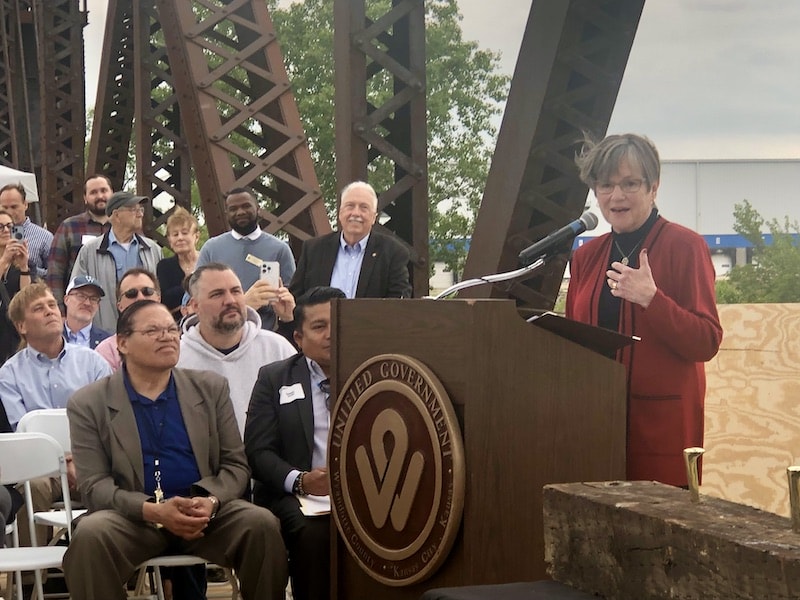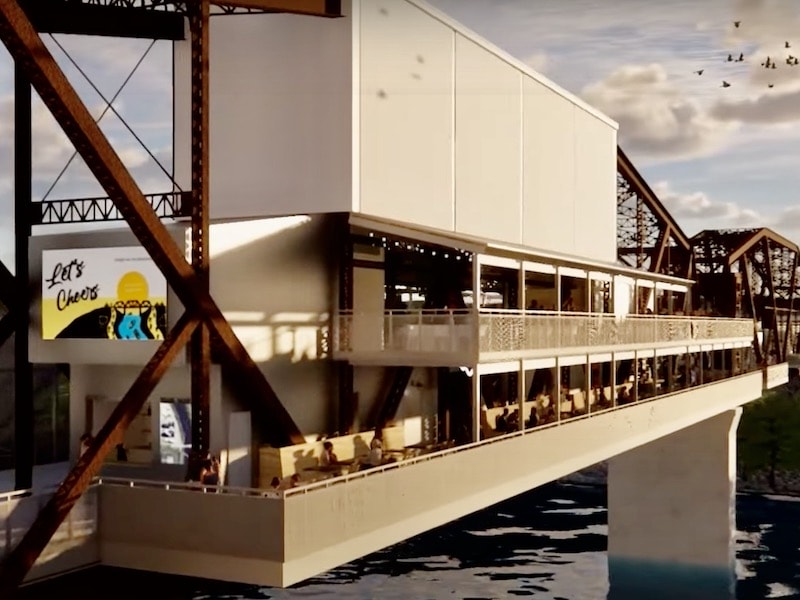Rock Island Bridge Project Gets $4M Boost from Kansas

Published May 18th, 2023 at 11:30 AM
By Kevin Collison
Attendees at a ceremonial kickoff for the Rock Island Bridge project heard more than routine remarks from Kansas Gov. Laura Kelly this week, she also announced a $4 million state grant.
“I have been following this project for a long time and was very excited when Lt. Gov. (David) Toland brought it to me,” Kelly told the audience on the historic railroad bridge spanning the Kaw River behind Hy-Vee Arena.
“This project is steeped in history. In its heyday, the Rock Island Bridge was a regional driver of commerce carrying livestock and freight in and out of the West Bottoms.
“Today, we celebrate its revival.”
Adding to the celebration, she said the project had been chosen for a $4 million grant through the state SPARK (Strengthening People and Reactivating Kansas) economic development program established to distribute federal Covid recovery money.

Kansas Gov. Laura Kelly pounds a ceremonial gold spike at a ceremony launching the Rock Island Bridge redevelopment. On her right is David Brain and left is Shirley Helzberg, private contributors to the project. Daniel Serda, president of the KCK Chamber, was the emcee.
Kelly then joined other dignitaries in pounding a ceremonial gold spike into a railroad tie salvaged from the steel truss bridge. It was built in 1905 at the height of the livestock industry that bustled on both sides of the Kansas or Kaw River.
As the Kansas City livestock world faded in the 1950s, so did the bridge. It finally was decommissioned and ownership taken over by the city. Over time, it became another industrial relic in the Bottoms.
Until Mike Zeller discovered the old bridge while canoeing on the Kaw more than five years ago.
In a quest fueled by his indomitable belief it could be reborn as a recreational destination, Zeller has raised the public and private funding to begin construction on the Rock Island Bridge project.
The old bridge will be transformed to become a crossing for a Unified Government of Wyandotte County recreational trail network running along the river levees, and an entertainment district with food, drinks and an event space.

The Rock Island Bridge project includes a two-level structure housing bars and restaurants. (Rendering from promotional video)
KCK Mayor Tyrone Garner said the the redeveloped bridge also could provide a gathering space for community events like the KCK Farmer’s Market and La Placita market.
The county also plans to build a small park on the east side of the river that will include floating docks to allow people to launch their own canoes and kayaks or rent them from a potential private operator.
And if all goes according to plan, a zipline operator intends to run ziplines from the top of nearby Hy-Vee, the former Kemper, Arena across the river and between the arena’s unique exterior framework supporting its roof.
The $4 million SPARK grant is the largest source of public funding to date for the project, Wyandotte County is providing $2.4 million, and only trails the $5 million raised so far in private equity, Zeller said.
The extra help from Kansas is important because cost estimates have increased beyond the original $12 million because of construction inflation and the need to raise the bridge to clear the height of new levees being built by the U.S. Army Corps of Engineers.

The Rock Island Bridge opened in 1905 to transport livestock and other goods over the Kaw River during the heyday of Kansas City’s meatpacking industry.
“It’s a very big deal, a great big shove forward,” Zeller said. “It gets us close to doing what we want to do, right. We’re in a foot race with inflation.”
Fundraising continues for the venture in what’s being called the “Light the Bridge” campaign. Some of the major private donors are the Sunderland Foundation, Helzberg Foundation and Dickinson Foundation.
Zeller was pleased speakers at the construction kickoff event discussed how the old bridge is part of a new recreational future for that area of the West Bottoms. It’s being called the Waterfront District to move past its old industrial reputation.
“We’re very grateful they shared the vision for not only the bridge, but for the Kansas riverfront,” he said. “It’s the start of rebranding the river.”


